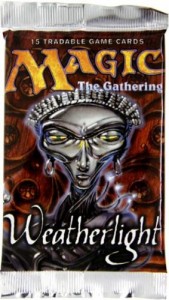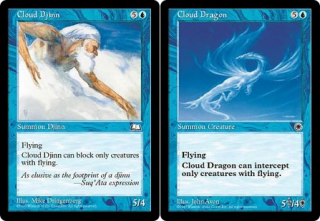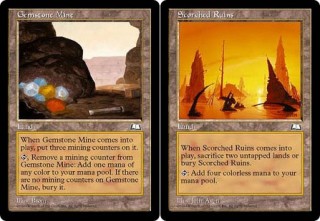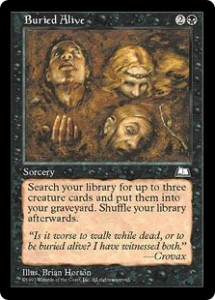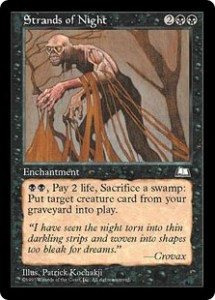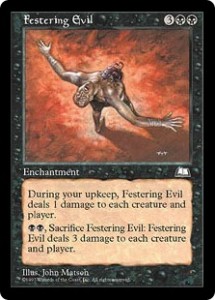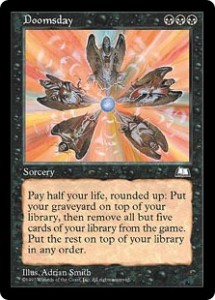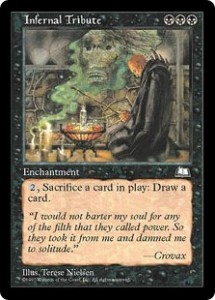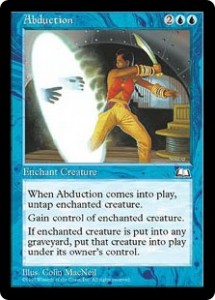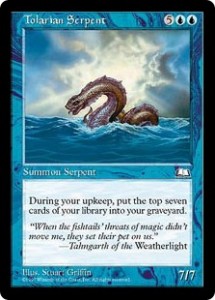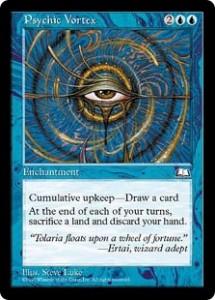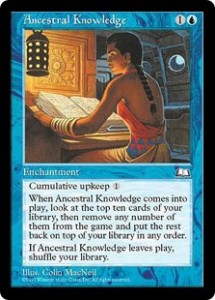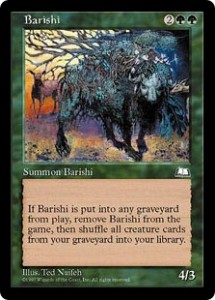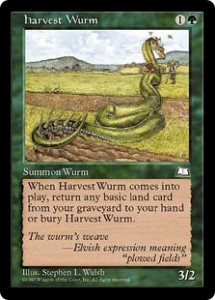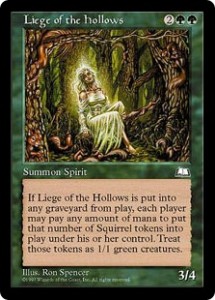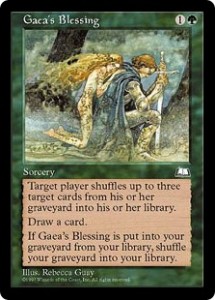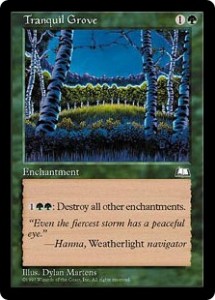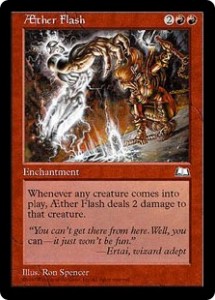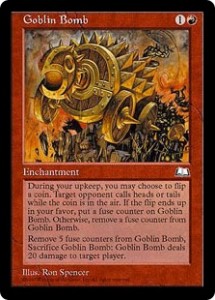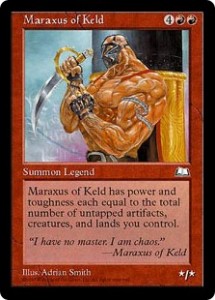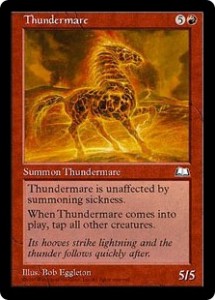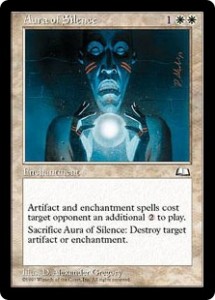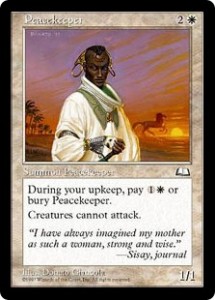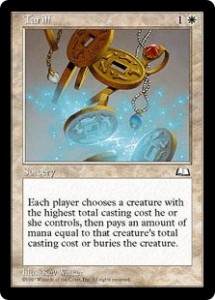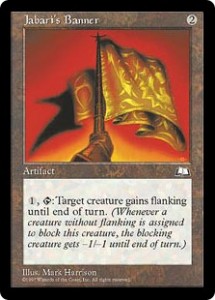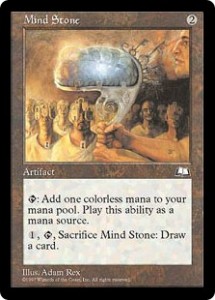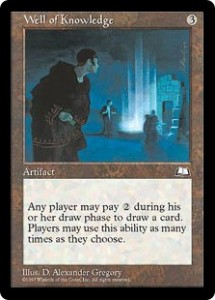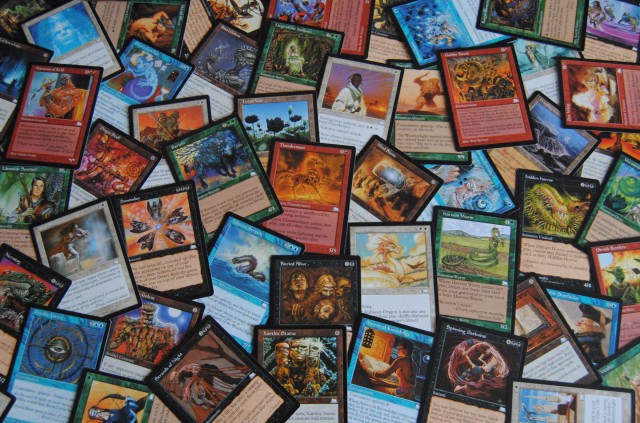
An Introduction to Weatherlight
Weatherlight was released on June 6th, 1997 and introduced many new and reinvented uses for the graveyard. It was the last set of the Mirage Block and still expanded upon the themes of Mirage. Phasing and Flanking were expanded and many tribes grew as well; Djinns, Efreets, Elves, Goblins, Dwarves, Dragons, Clerics and Knights.
Like Visions, Weatherlight consisted of 167 cards, but unlike Visions, it did not contain any gold or multicolored cards. The color breakdown was 4 Lands, 29 Black cards, 29 Blue cards, 29 Green cards, 29 Red cards, 29 White cards and 18 Artifacts. The rarity breakdown, however, was exactly the same as Visions at 62 commons, 55 uncommons and 50 rares.
Weatherlight included two functional reprints from Portal, a set created to help introduce Magic: The Gathering to beginners.
The functional reprints were, Cloud Djinn a reprint of Cloud Dragon with a changed creature type and Fallow Wurm a reprint of Thundering Wurm. As Portal would continue with Portal II, other cards would be moved from the “beginner’s” set to other future expansion sets.
There was a decent amount of balance within the set, although that’s arguably more difficult to decipher if you’re playing style isn’t generic and is more based in one color, but it was still a balanced enough set, that no one color had all the power cards.
Weatherlight also set the stage for the Rath Block of Tempest, Stronghold and Exodus, with a story line that was “without their captain, the crew of the weatherlight must scour the planes-searching not only for the kidnapped Sisay, but also for the pieces of The Legacy, the only thing that can save Dominaria from destruction at the hands of the demon Yawgmoth.”
The Lands of Weatherlight: The Four Lands
There were only four Lands in Weatherlight, but they had a lasting impact on the game. Gemstone Mine, came into play with three counters on it and could be tapped for any color of Mana, but each time a counter was removed, until the third and last counter was removed and the Land was buried. This may have only been a temporary Land at best, but it was powerful in many decks and could be utilized without losing Mana advantage, when it was gone.
Scorched Ruins, could be tapped for four colorless Mana, but when it came into play you had to sacrifice two untapped Lands. However, with the ability to regain lost Lands from the graveyard now prevalent within Magic, this wasn’t as great a sacrifice, because it was printed after Alliances came out, when those cards started to multiply.
Lotus Vale, also had a steep cost to get it into play at sacrificing two untapped Land, but it could be tapped for three mana of any one color (sound familiar?). So in most cases it was well worth the cost and again, those sacrificed Lands could be salvaged with other cards.
Winding Canyons could give you one colorless Mana, but it was its other ability that was its main use. Pay two colorless Mana and TAP Winding Canyons to allow you the ability to play creatures whenever you could play Instants. This gave creature heavy decks, the ability to spring a creature out during an opponent’s turn and then attack with that creature during your turn, which is a huge advantage.
The Color Black in Weatherlight: It’s a Highway to and from the Graveyard
Black in Weatherlight was mainly focused on graveyard manipulation; from the graveyard to play, to the graveyard and removed from the game. This along with some creatures and spells made it a nice compliment to the color as a whole.
One rat was added to the tribe in Razortooth Rats and another knight in Shadow Rider, a 3/3 Flanking creature was added, as well. There were also three big or useful creatures that had painful upkeeps. Fledgling Djinn was a 2/2 flyer that dealt you one damage during your upkeep, while Gallowbraid was a 5/5 trample Legend and Morinfen was a 5/5 flying Legend, both of which had a Cumulative Upkeep of 1 life.
For reanimator decks, two cards allowed you to get creatures into your graveyard faster than others. When the 4/4 Hidden horror came into play, you had to discard a creature card from your hand and Buried Alive was a Sorcery that allowed you to “search your library for up to three creature cards and put them into your graveyard.” Both of these cards were instrumental in bolstering the reanimator deck, but what about getting those creatures from the graveyard back into play?
Strands of Night was an Enchantment, that allowed you to pay two Black Mana, two life and a sacrificed Swamp to bring back a creature from the graveyard. Bone Dancer, if unblocked allowed you to put the top creature card from an opponent’s graveyard into play under your control and as a mere 2/2, it was easy to make the Dancer unblockable.
Meanwhile, if you just wanted to get a creature back into your hand, Shattered Crypt could return X target creatures to your hand from your graveyard for X and two Black Mana, but you would also lose X life, so it wasn’t wise to use this often.
Weatherlight’s Black also had use for creatures in the graveyard, if they were removed from the game from there.
Black’s first Atog in Necratog got a +2/+2 boost for removing the top creature card in your graveyard from the game, where Barrow Ghoul was a 4/4 for one colorless and one Black Mana, that had an upkeep of removing the top creature card in your graveyard from the game.
For a direct damage approach, haunting Misery cost one colorless and two Black Mana, where you could then removed X creature cards in your graveyard from the game to have it deal X damage to target player. The drawback to haunting Misery was that you could only target players and not creatures, but it was still useful.
If you wanted flat-out damage to be your goal, Festering Evil was a Pestilence during your upkeep and could be sacrificed to deal three damage to each creature and player. Urborg Stalker dealt one damage to each player during their upkeep if they controlled any nonblack permanents other than land. Spinning Darkness cost six converted mana for a Drain Life of three, but you could removed the top three Black cards in your graveyard from the game instead of paying its cost. Fatal Blow was good for all those big creatures, because it buried target creature that was damaged this turn, making one damage deadly to any creature in play.
Destruction was in the cards with Wave of Terror, which had a Cumulative Upkeep of one Mana, but it was worth the cost because, “at the end of your upkeep, bury each creature with casting cost equal to Wave of Terror’s last paid cumulative upkeep.” Urborg Justice, was a great play after your army was wiped out, because it made target opponent bury a number of creatures equal to the number of creatures put into your graveyard from play this turn. Lastly, Abyssal Gatekeeper was a 1/1 that didn’t die alone. If it was put into the graveyard from play, each player had to choose and bury a creature her or she controlled.
Discard decks were not left out of Weatherlight either, Odylic Wraith was a 2/2 Swampwalking creature, that made a damaged player choose and discard a card. While Tendrils of Despair, allowed you to sacrifice a creature (which could just be a token) to make target opponent choose and discard two cards.
With all of these great options to add to any deck with Black in it, there are still two Black cards in Weatherlight that deserve special attention; Doomsday and Infernal Tribute.
Doomsday, was a Sorcery that said, “pay half your life, rounded up: Put your graveyard on top of your library, then remove all but five cards of your library from the game. Put the rest on top of your library in any order.” This was risky against Blue, or even against anyone if played early on, but in order to finish off an opponent, it doesn’t get more offensive than this.
Infernal Tribute was pure Black card draw as only Black could do it. Pay two colorless Mana and sacrifice a card in play to draw a card. Now, with all of Black’s graveyard manipulation getting back sacrificed cards was easy. Or should you have a lot of Mana, and you already have the creatures you want in play, pairing the Tribute with Ice Age’s Enduring Renewal, could give you immense card draw, although not unlimited, because of the Mana cost associated with it.
This was also a good play in response to something. A creature that’s blocking something much bigger than itself, would be the only thing that died anyway, so why not block and sacrifice it to draw a card? Seems like a better trade off than just putting it in the graveyard. With Infernal Tribute, Black could give itself a great card draw advantage, and it was also a way around Necropotence’s skip your draw phase.
The Color Blue in Weatherlight: Counters, Control and Card Draw or Normal Blue
Blue got some great control cards with Weatherlight. Abjure allowed you to pay one Blue Mana and sacrifice a Blue permanent to Counter target spell, whereas Disrupt was a Force Spike for Instants, Interrupts and Sorceries with a cantrip attached to it.
Abduction was a Control Magic, but gave the creature back to it’s original owner when it died. Mana Chains gave enchanted creature a cumulative upkeep of 1 and Pendrell Mists gave every creature a “during your upkeep, pay one colorless Mana or bury this creature.”
On the creature front, Tolarian Enchanter allowed you to steal any creature that blocked it, which was great with Lure and Regeneration.
Cloud Djinn was a 5/4 flyer that could only block other creatures with flying, Phantom Warrior was an unblockable 2/2 and Vodalian Illusionist was a 2/2 Merfolk that could make target creature phase out.
Ertai’s Familiar took phasing to a whole new level. It was a 2/2 with phasing, that when it left play, put the top three cards of your library into your graveyard. You could turn the phasing off for one Blue Mana, but if you could trade it with an opponent with no sources of Blue Mana, you had a Millstone plus an extra card on them every other turn.
Meanwhile, also for Millstone decks and Reanimator decks, as well, was Tolarian Serpent, which had an upkeep of “during your upkeep, put the top seven cards of your library into your graveyard.” You could trade this with your opponent to get them milled faster or you could use it to stockpile your graveyard for a future play. Either way, this 7/7 serpent was useful many times over.
Fog Elemental on the other hand was a two colorless and one Blue Mana costing 4/4 flyer that was buried if it saw any combat. This didn’t stop it’s use. While, Manta Ray was a 3/3 with Islandhome and a Fear in Blue.
Blue’s Weatherlight was also about card draw. Flux allowed each player to discard any number of cards, then draw that many cards, plus it had a cantrip for you. Merfolk Traders had a draw a card, discard a card when it came into play ability and Ophidian was a 1/3, that allowed you to draw a card if it was unblocked, but rendered it dealt no damage.
Psychic Vortex was an immense card draw enchantment with a cumulative upkeep of “draw a card,” but “at the end of each of your turns, sacrifice a land and discard your hand,” so you had to play it in the right kind of deck, or it would destroy you. If you needed to trade your library for your graveyard, Paradigm Shift, allowed you to remove your library from the game and then shuffle your graveyard into your library.
Want to get something back from the graveyard without something as complex as the Paradigm Shift? Relearn allowed you to pull back an Instant, Interrupt or Sorcery to your hand and Argivian Restoration would put an artifact from your graveyard back into play, which was a great way to cast some of the larger Artifact Creatures.
Noble Benefactor was interesting in that when it was put into the graveyard from play, it became a Demonic Tutor for each player, so that made it very balanced, you get to search your library for a card to put into your hand, but so did you opponent. The only way to really combat this was to have a Black / Blue discard deck and make them discard the card they just picked out of their library.
Ancestral Knowledge was the standout as a sort of Blue Sylvan Library. It had a cumulative upkeep of one colorless Mana, but when it came into play you looked at the top then cards of your library and removed any number of them from the game, putting the remaining cards, back on top of your library in any order. Of course, if Ancestral Knowledge left play you had to shuffle your library, but with all of Blue’s card draw and with a few Ancestral Knowledges in your deck, you could easily make the most of it, while you had it in play.
The Color Green in Weatherlight: A little more than just Elves, Squirrels and Enchantments
Green didn’t add anything new to it’s arsenal, so much as it just improved upon existing themes. We’re talking about an emphasis on creatures with a few spells and powerful enchantments.
Aboroth was a 9/9 with a cumulative upkeep of “put a -1/-1 counter” on it, so it wouldn’t stay big for long and it didn’t have trample, which was kind of a let down. Arctic Wolves, also had a cumulative upkeep, but was a 4/5, that had a cantrip.
Barishi was one of the standout creatures of the set. It was a two colorless and two Green Mana costing 4/3 with a great ability. “If Barishi is put into the graveyard from play, remove Barishi from the game, then shuffle all creature cards from your graveyard into your library.” This was a massive card for creature heavy Green decks at the time, because it replenished your army, four times, if you had the full play set in your deck.
Harvest Wurm and Fallow Wurm, were great cards to play back to back. Fallow Wurm was a two colorless and one Green Mana costing 4/4, that made you discard a Land card from your hand. Harvest Wurm was a great follow up, because it was a one colorless and one Green Mana costing 3/2, that made you return any basic Land from your graveyard to your hand. If one followed the other, you’d have two decent creatures in play and you wouldn’t have lost the land at all.
Rogue Elephant was also a good play before Harvest Wurm, because it was a 3/3 for one Green Mana, that made you sacrifice a Forest when it came into play. Again, Harvest Wurm will give you back the sacrificed Forest.
The Elven clan of Llanowar had their day in the sun with Weatherlight. Llanowar Druid could be sacrificed to untap all Forests and with all that Mana you could cast plenty of Llanowar Sentinels, which when it came into play allowed you to pay an additional one colorless and one Green Mana, to search your library for an additional Llanowar Sentinel and put that one into play as well. Even bigger was Llanowar Behemoth, a 4/4 that could be pumped for +1/+1 by tapping a creature you control.
Meanwhile, the elves weren’t the only creatures having fun in Weatherlight’s forests. Liege of hollows was a 3/4, that when it died, allowed each player to pay any amount of Mana to get that number of 1/1 Squirrel tokens into play under their control. With the right timing, I’ve seen a player tapped out in a duel, have his opponent, sacrifice their Liege, to gain eight Squirrel tokens, leaving them with none. That’s quite the creature advantage.
With that kind of Mana, Mwonvuli Ooze was quite the late game play for many Green decks. It was a one Green Mana costing 1+*/1+* creature with a cumulative upkeep of two colorless Mana, where it’s * for power and toughness were equal to the last paid cumulative upkeep. Again, without trample the Ooze wasn’t really used.
Uktabi Efreet was a 5/4 with a one Forest cumulative upkeep, but he wasn’t nearly as valuable as Veteran Explorer. The Explorer, like the Noble Benefactor, allowed each player, when it was put into the graveyard from play, to search for and put into play up to two basic land cards. But like the Benefactor, because this affected all players, it needed to be carefully used, for it could backfire easily.
Four spells rose above the rest for Green in Weatherlight. Vitalize allowed you to untap all creatures you control, which for Green gave you double the creature Mana sources. Nature’s Resurgence allowed each player to draw a number of cards equal to the number of creature cards in his or her graveyard, so with a Tormod’s Crypt, you could nullify this effect on your opponent.
Choking Vines, was an Instant that could render X creatures blocked and deal them each one damage for X plus one Green Mana, but the power spell for Green was Gaea’s Blessing. Gaea’s Blessing allowed target player to shuffle up to three cards from his or her graveyard into his or her library and then allowed you to draw a card, which you could use on yourself, or to piss off someone playing a reanimator deck. The card was also Millstone proof, because “if Gaea’s Blessing is put into your graveyard from your library, shuffle your graveyard into your library. This made the Blessing, extremely useful.
But I did say there were some powerful enchantments in Green. Briar Shield was a +1/+1 enchant creature that could be sacrificed for the power of a Giant Growth, which is a nice option to have. Downdraft was a good answer to Green’s lack of flying power, because it could remove flying from a creature or be sacrificed to deal 2 damage to each creature with flying.
Dense Foliage made all creatures unable to be the target of spells, although abilities could still affect them. While, Familiar Ground made each creature you control cannot be blocked by more than one creature. This when paired with Fallen Empires‘ and Fifth Edition‘s Goblin War Drums, made all of your creatures unblockable.
Call of the Wild allowed you to pay two colorless and two Green Mana to reveal the top card of your library to all players. If it is a creature card, put it into play, otherwise bury it. Now, if played in conjunction, with a Sylvan Library you can be casting large creatures with huge casting costs for only four Mana and that’s a bargain.
Last, but certainly not least was Tranquil Grove. Once cast it was a permanent Tranquility, with it’s activation cost of one colorless and two Green Mana it destroyed all “other” enchantments. Now this could backfire on you as well, but it was a brilliant way to deal with some of the powerful enchantments that existed at the time and those that were still to be printed in future sets.
The Color Red in Weatherlight: Holding the Status Quo for Red
Red was given the status quo for Red in Weatherlight; direct damage, big creatures and offensive spells.
Two was a magic number in Weatherlight’s Red cards. Aether Flash dealt two damage to any creature that came into play. Bogardan Firefiend dealt two damage to target creature if put into any graveyard from play. Lava Storm gave you the choice to deal two damage to each attacking or each blocking creature and Cinder Giant was a 5/3 that during your upkeep dealt two damage to each other creature you control, but it wasn’t all about two damage.
Cone of Flame dealt three damage, two damage and one damage to any target creatures and/or players. Heart of Bogardan had a cumulative upkeep of two colorless Mana, that when not paid, dealt damage to target player and each creature he or she controls equal to the last paid upkeep cost. Firestorm only cost one Red Mana, but allowed you to discard X cards to have it deal X damage to each of X target creatures and or players, which could be big damage if played after Visions‘ Prosperity.
Thunderbolt cost the same as an Incinerate but could deal three damage to a player or four to target creature with flying, while Fire Whip could make any creature a Prodigal Sorcerer (Tim).
If you were in a gambling mood, you could play Desperate Gambit. Flip a coin and if you won, you could double the damage dealt by a source you control, or it would be prevented. But that wasn’t the only flip a coin card. Goblin Bomb had you flip a coin during your upkeep, if you wished, if you won the flip a fuse counter would go on the Bomb and if you lost, a fuse counter would be removed. When you had a total of five fuse counters on Goblin Bomb, you could remove them and sacrifice it to deal 20 damage to target player. If you could get it to go off, it was usually an instant win.
Four tribes were boosted with additional creatures in Weatherlight’s Red creatures. Goblins Grenadiers and Goblin Vandal added to Goblin decks, hurloon Shaman added to Minotaurs, but the biggest winners were the tribes of Dwarves and Orcs.
The Orcs had Orcish Settlers, which could be sacrificed for a XX cost to destroy X target Lands. The Dwarves on the other hand, had even better additions. Dwarven Berserker was a 1/1 that if blocked becomes a 4/1 trampler until end of turn. Talk about a reason to hold onto a Blood Lust, because then you’d have an 8/1 trampler to rival the Ball Lightning. The Dwarves also received Dwarven Thaumaturgist which had the ability to switch a creature’s power and toughness with each other. Which could render Alliances‘ Yavimaya Ants a 1/5 trampler, which is nothing to fear at all.
Cinder Wall was like a Lightning Bolt, as it was a one Red Mana casting cost 3/3 wall that was destroyed when it was used to block. Bloodrock Cyclops was an inexpensive Juggernaut, although it was only a 3/3. Lava hounds was a two colorless and two Red Mana costing 4/4, with no summoning sickness that dealt you four damage when it came into play.
Meanwhile, Roc hatchling was a 0/1, that came into play with four counters on it. The counters are removed, one by one, during your upkeep, and when the last counter is removed it becomes a 3/3 flyer and it only cost one Red Mana to cast plus it’s a bird, which is now a very large tribe.
All of those creatures could be boosted with Betrothed to Fire, an enchant creature that allows other creatures to be sacrificed to give enchanted creature +2/+0, or +2/+0 to all other creatures if the enchanted creature is sacrificed. More in line with Blood Lust was Fit of Rage which gave target creature +3/+3 and First Strike until end of turn, which started to give rise to the Red steroid deck.
The enchantment Fervor made all creatures you control unaffected by summoning sickness, which for its time gave Red a huge advantage, although Red still had more creatures unaffected by summoning sickness than other colors at that time.
There were two very large and powerful creatures in Red; Maraxus of Keld and Thundermare. Maraxus of Keld was a Legend with a power and toughness equal to the total number of untapped artifacts, creatures and Lands you control. Because it cost four colorless and two Red Mana, if you cast it on turn six, with six Land in play, it was at least a 6/6, plus all the other creatures and artifacts you may have cast.
The downside to Maraxus was that you had to keep an eye on how much Land you used, because you tapped Land for casting other things, could easily make Maraxus a target as it’s toughness, fluctuated down.
Thundermare, on the other hand was a relentless power offensive creature. It cost five colorless and one Red Mana, making it easier to cast in Red and Green decks. It was a 5/5 that was unaffected by summoning sickness, which would be good enough, but it had an additional ability. “When Thundermare comes into play, tap all other creatures.”
This means that when cast, Thundermare gets a free shot at your opponent. If you could save up three additional Mana, you could even cast a Blood Lust and gamble on Desperate Gambit for a chance at dealing your opponent 18 damage. If it all came up in your favor, all you need to do to kill your opponent, if they’re still alive, is draw a Lightning Bolt or Incinerate; game over.
The Color White in Weatherlight: Peace for Creatures, Artifacts and Enchantments
For all of the control that Blue is known for, White took a page out of Blue’s book in Weatherlight.
Artifacts and Enchantments are usually powerful in White decks and Weatherlight gave White the ability to protect itself from them and return them. Argivian Find allowed you to return target Artifact or Enchantment from your graveyard to your hand. Serenity buried all artifacts and enchantments during your upkeep, while Aura of Silence made all artifacts and enchantments, target opponent casts, cost an additional two colorless Mana. The Aura also could be sacrificed and used as a Disenchant if one was cast that you wanted to destroy.
One of the more powerful creature enchantments that was in White was, Empyrial Armor, which gave target creature +X/+X, where X was equal to the number of cards in your hand. This could be a boon, if it was cast early in the game and was one of the best draws you could get, if playing in a sealed-deck tournament at that time (if you could cast it, that is).
Creatures could be controlled and protected. Inner Sanctum had an expensive cumulative upkeep of two life, but made all damage dealt to creatures you control zero. While, Peacekeeper, with a much more reasonable upkeep of one colorless and one White Mana, simply stated “creatures cannot attack.” However, as a 1/1 the Peacekeeper was an obvious target for creature heavy opponent decks.
There were other creature’s with great uses. Benalish Hero was a 2/2 Knight that could be cast as an Instant and Foriysian Brigade was a 2/4 that could block two creatures, which was a throwback to Two-Headed Giant of Foriys from Unlimited.
Duskrider Falcon was a 1/1 with protection from Black and Fourth Edition‘s Northern Paladin was given a comrade in arms in Southern Paladin which could destroy target Red permanent.
There were a few classic White characteristic cards, like Gerrar’s Wisdom which was the anti-Storm Seeker gaining you two life for each card in your hand. Serra’s Blessing made all of your creatures able to attack without tapping and Revered Unicorn was a source of life gain, with a cumulative upkeep, that when the Unicorn died would gain you life equal to the last paid upkeep.
Mistmoon Griffin, in addition to bolstering the Griffin tribe was an unexpected reanimator card for White, that when it died was removed from the game in exchange for putting the top creature card in your graveyard into play.
Classic White Weenie decks rarely had creatures that cost more than a few Mana, and as such Tariff was a great play. It made each player pay an amount of Mana equal to the highest casting cost creature controlled in order to not bury that creature. Again, cheap White creatures are easy to repay for.
Alabaster Dragon, also added to a burgeoning Dragons tribe and, was a creature that was hard to remove from the game. If it was put into the graveyard from play it was shuffled back into it’s owners library. Although it was an expensive 4/4 flyer, this is immensely useful for not loosing your Dragon, when you Wrath of God to clean the board.
Speaking of Wrath of God, you could pair it with Angelic Renewal, which was an enchantment that could be buried to return a creature put into the graveyard from play this turn, back into play.
With a Wrath of God, this leaves you with the only creature left on the board, so make it a good one. This was even better with Jokulhaups, as your opponent wouldn’t have any Land or Artifacts to deal with your lone creature. Leaving that creature as the last man standing, so to speak.
If you required your opponent’s complete silence for an entire turn, Abeyance was the way to get your spells cast without issue. “Until end of turn, target player cannot play instants, interrupts, sorceries or abilities requiring an activation cost. Draw a card.” The card draw was nice, but not nearly as nice as silencing a Blue deck, to allow you to cast your combo or game winning spells without interruption.
The Artifacts of Weatherlight: Useful Artifacts with plenty of Uses
The Artifacts of Weatherlight were very well balanced between cards that were used in specific decks and those that could have much broader uses across many different deck themes.
Bosium Strip allowed you to recast spells from your graveyard, one last time, before removing them from the game and Jabari’s Banner gave target creature Flanking. While Thran Forge allowed you to boost a creature’s power and make it an artifact creature, allowing you to get around those pesky Circle of Protections.
Bubble Matrix offered creature protection with all damage dealt to creatures being reduced to 0. This was great for Tim decks or creature combo decks, because you could target your opponent and not worry about losing your creatures. And Serrated Biskelion was a 2/2 creature similar to Homelands‘ Serrated Arrows, but it would only last 2 times without a buff to itself.
Mana Web was a great way to tie up your opponent’s Lands, forcing them to tap all Mana that can produce the type of Mana used from the first tapped Mana. So if they needed Blue Mana, any Land they controlled that could produce Mana would be tapped as well.
Mind Stone, on the other hand, was an instant addition to most decks, because it could be tapped for one colorless Mana or it could be tapped and sacrificed, with the payment of one colorless Mana for a card draw. Fourth and Fifth Edition‘s Dingus Egg, got a sister of sorts in Dingus Staff, which dealt two damage to a player when ever any creature of theirs was put into the graveyard from play.
Null Rod created havoc with some decks because it simply stated, “players cannot play any artifact abilities requiring an activation cost.” Whereas, Touchstone allowed you to tap target artifact you do not control. Both could render some combos useless.
Steel Golem and Straw Golem were both cheap and powerful artifact creature’s with a downside.
Steel Golem was a three colorless Mana costing 3/4, but it stated that “you cannot play summon or artifact spells,” whereas Straw Golem was a one colorless Mana costing 2/3, that would be buried if any opponent successfully cast a summon or artifact spell. One use Steel Golem had was with Chronicles‘ and Fifth Edition‘s Gauntlets of Chaos, to trade it to your opponent and make them unable to cast artifacts or creatures.
Against, the now extremely common Reanimator decks, Phyrexian Furnace was a force to be reckoned with. You could tap it to remove the bottom card of target player’s graveyard from the game, but in a pinch it could be sacrificed to remove any card in their graveyard from the game. If you had four in your sideboard, since they only cost one colorless Mana to cast, you might be lucky enough to get two in play early and keep your opponent from even having a graveyard. But that was much more luck than anything else.
Classically, 8/8 or larger creatures are expensive; 11 Mana for the 11/11 Polar Kraken from Ice Age, nine Mana for the 9/9 Colossus of Sardia and the 10/10 Leviathan both from Fourth Edition, seven Mana for the 8/8 Marjhan from Homelands and six Mana for the 8/8 Force of Nature from Fourth and Fifth Editions.
Xanthic Statue cost eight Mana to cast, but only cost five Mana to activate as an 8/8 trampler, until end of turn. When compared with the fact that it could be used when it was needed and didn’t have an upkeep, although it did have an activation cost, it was a cheap 8/8 trampler. It could also be protected from Wrath of Gods as well.
By now, howling Mine was the classic card for additional card draw during your draw phase, but Well of Knowledge gave players another option, that could be exploited to better serve you and not allow your opponent the same bonus. Howling Mine allows players to draw an additional card during their draw phase, while Well of Knowledge allows players to do the same at a cost of two colorless Mana per card.
This meant, if you were playing Green, with it’s abundance of Mana sources or had available Mana you could draw additional cards and you could make sure you had built your deck around that. Whereas your opponent, would have to choose, between the extra draw and the possibility of not having enough Mana left over to cast, whatever it was they drew.
This was also a way around Island Sanctuary, because you could still decline to draw one card, while paying the extra Mana for a draw, meaning that those Island Sanctuary / Mystic Decree lock down decks, now had a source of card draw each and every turn. This was a huge shift and made people think twice about whether to use howling Mine or Well of Knowledge.
In Conclusion Weatherlight
Now for the mythic nature of Weatherlight it was a very important set, as the story line I mentioned in the introduction carried through 2001, but the set of cards that made up Weatherlight the expansion was underrated at best.
Not because it wasn’t good, or because the cards weren’t useful, but because it didn’t have the flair of Alliances or the power of Visions. Yes, it did have some flair and yes it did have some power, but it was neither in contrast with the other two, which it was greatly compared at the time.
By straight comparisons, it was not as versatile as Visions or as game changing as Alliances, but it was still a good set. It’s effect on the game was subtle, but it was a set close to the blueprint set forth by Visions and was the last expansion to follow the 167 card blueprint. All of the future expansions, that weren’t stand alone expansions like Ice Age and Mirage, would contain 143 cards, after Weatherlight. So it’s legacy was to end that which was started by Alliances.
It was the last of the second generation of expansions. The first generation of Antiquities, Arabian Nights, Legends, Fallen Empires and The Dark, were all over the place, but from the Ice Age through Weatherlight, there seemed to be a linear continuation of themes and card styles. This linear progression would not end with Weatherlight, as future sets would be built off of the Mirage and Ice Age Blocks and the linear momentum, could not be stopped.
